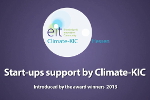Open Access Catastrophe Model (OASIS)
Challenge Platform: Adaptation services
Project Start Date: 11/2011
Lead partner: Imperial College London, UK
Project type: Innovation – Develops and brings to market climate-relevant knowledge, services and products
Project lead: Ralf Toumi, Imperial College London
Partners
The OASIS project involves 7 partners:
- Imperial College London, UK (Climate-KIC Core Partner)
- Delft Technical University, NL (Climate-KIC Core Partner)
- Institut Pierre Simon Laplace (IPSL), France
- CLIMPACT, France
- Deltares, NL (Climate-KIC Core Partner)
- Aria Technologies, France
- NUMTECH, France
Concept
With the frequency and severity of natural disasters increasing, the cost of catastrophe loss is soaring and governments, corporations, aid organisations and tax payers are left to bear the costs. The Open Access Catastrophe Model (OASIS) project will present a new open-source model that addresses the uncertainty of natural disasters and combats the setbacks of existing models.
The Climate Change Issue
Over the past century, the frequency and intensity of many natural disasters has increased . It is believed that rising global temperatures and warming of oceans are the cause of this. Higher temperatures accelerate evaporation leading to heavy rainfall and a high risk of flooding, likewise warmer oceans can lend much more energy to storms, dramatically increasing the intensity and frequency of typhoons and hurricanes. Many communities have become increasingly vulnerable and less equipped to cope with these changes.
The Project Solution
OASIS is an open source model with a range of modules for commercial users to choose from. It allows assessment of a range of risks posed by natural disasters, which is a unique feature to OASIS. It also addresses many of the problems associated with existing models, such as geographical coverage, computing time taken to determine loss, and transparency. Importantly it is accessible to all stakeholders rather than being exclusive to the insurance industry.
With this information a degree of preparation can be carried out and vulnerability can be reduced.
The overall aim of the project is to provide insurers with the ability to offer realistic pricing for security from climate risk and reduce the vulnerability of stakeholders. A range of prototypes will demonstrate the effectiveness and economic potential of OASIS.
The Role of Climate-KIC
Through Climate-KIC’s funding the project has benefitted hugely. The potential held by the project has been widely recognised and the industry, as a whole, has been encouraged to get on board. Climate-KIC provides a vast network of partners, meaning every aspect of the project can be focused on with a high level of expertise.



